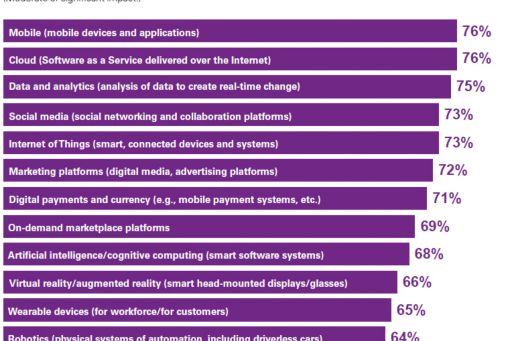Seismic shifts: The organizational impacts of disruptive technologies
The organizational impacts of disruptive technologies
Disruptive technologies are enhancing technology companies’ business models and operating models.

Across a broad spectrum of technology areas, from D&A to digital payments, IoT to robotics, senior technology business leaders are utilizing disruption to change how they run their operations and serve their customers.
Disruptive technologies are improving the operating model
Disruptive technologies have enormous potential to enhance the underlying economics of specific business processes, to drive higher productivity, make workflows more efficient, speed up the supply chain and transform the back-office. These advances are especially relevant to tech manufacturers, but software and app-based players can also enjoy a step-change in operational performance.
In addition to boosting productivity, our research reveals that disruptive technologies are also making a difference to quality and cost. Almost half (49 percent) of survey respondents state that the Internet of Things (IOT) is a key driver of business productivity – from improving employee efficiency and project timelines to restructuring supply-chain processes and more.
Data & Analytics (D&A), on the other hand, can drive better forecasting, by analyzing sales patterns and linking these to the supply chain, to optimize purchasing and inventory and react faster to changes in demand. And many routine, repeatable, back-office tasks are utilizing the software robotics to automate and speed up processes.

Disruptive technologies are transforming business models and the customer experience
Everywhere we look, technology companies are seeking new ways to service customers digitally, using the power of D&A to understand needs and make offerings personalized. Tech executives believe that a wide range of disruptive technologies are aiding this transformation, with mobile, cloud and D&A leading the way, and many others close behind.
Of the technologies considered to have the most impact, IoT is
the leader in developing new products and services and D&A is being used to
market to customers more effectively.

Tech firms are investing in many areas of disruption
Investments are an indicator of the emergence of disruptive technologies, and reveal where the technology industry is placing its bets. In a fast-moving sector, leaders need to know where competitors’ priorities lie, and whether particular technologies can bring them an advantage.
Our survey findings suggest that most firms are casting the net widely, investing in a number of different technologies simultaneously.

In our view, investment objectives should be determined by the sector a company is operating in (software, hardware, e-commerce etc.) and its strategic objectives (fast growth, low-cost, mass-market, premium positioning etc.). The technology industry leaders taking part in the survey appear to have two over-riding priorities when investing in disruptive technologies: product strategy and business operations.